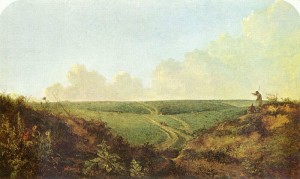
Painting The Norfolk Broads. They are renowned for their early morning mists, beautiful lakes and rivers (known as broads). You will also find windmills, trees, wildlife, boats and sailing craft of every shape and size. Also boathouses, low bridges, old stone ruins, and a few human ruins. Sorry, I couldn’t help it, I mean artists, setting up their easels. It is an area very popular with artists, trying to capture some of this magical atmosphere.
Of course we’re not the first to notice these natural beauties.
The Norwich School of Art were painting the Norfolk broads when the school was founded in 1803. It was made famous by John Crome, John Sell Cotman and Joseph Stannard, to name a few.
Their works went on to influence the artists of the French Impressionist movement.
Atmosphere
is what we as artists are trying to capture in paint. To accurately record the scene before our eyes, isn’t inherently difficult. Even a camera can do that quite well.
But the artist seeks to capture the ‘atmosphere’ which attracted him or her to the scene. That might be the early morning mist, the sound of the ducks. The way the light is filtered through the tree branches, the smell of the woodland. Or any and all the other senses that the artist is experiencing.
It’s not surprising then why I and so many other artists prefer to work out doors, directly from nature.
It is also no surprise to learn that paintings and sketches made on a rainy or misty day, perhaps in the snow even. Or beneath a magical evening sky, in the early morning light, very often manage to capture something special about that atmosphere. Something that in a way studio work rarely does.
For the same reasons working from photographs is almost never successful.

So you might think we have the best job in the world? Visiting interesting places, checking out stunning scenery, painting until the light fades away. Well yes and no, that is the creative part of the role, and it has many excitements and disappointments. Not least when a few spots of unexpected rain can ruin an hour and a half’s work in watercolour. Or a sudden gust of wind carries away the easel, complete with firmly affixed wet painting. This can end up in a scramble over the rocks or a dip in the cold algae covered lake to retrieve said masterpiece.
Of course, this is all forgotten when the next attempt is a success.
what about other tasks?
The other part of the ‘job’ is less creative, and more ‘sales and marketing.’ A subject which doesn’t come naturally to many creative people.
So it’s, framing and mount cutting, cataloging and pricing, entering competitions. Talking to galleries, planning exhibitions, placing work in Internet shops.
Writing detailed descriptions, packing and sending paintings. Web site building and maintenance and writing blog articles, such as this. All very interesting and it has to be done, but still it keeps us from getting out there and being creative as much as we’d like.

To follow my continuing story, do make sure you put your e-mail address in the box on this page.
It will keep you up to date and ensure you don’t miss my next posting.
To see earlier blog posts – click on this photo.
